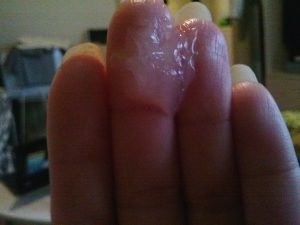Among the many difficulties women may encounter when trying to get pregnant, there is one that causes a lot of speculation and doubts, particularly among fertility specialists. This is hostile mucus, or hostile cervical mucus, as it is called in medicine. It can be one of the causes of female infertility by preventing sperm from surviving inside the woman’s body.
Throughout a woman’s cycle, the body naturally produces mucus in the cervix. During the fertile period this mucus changes and adapts, becoming stretchy, slippery, and clear, similar to egg white. The mucus changes to help sperm move so they can reach the fallopian tubes and fertilize the egg1. This type of mucus also helps sperm survive longer inside the female reproductive system, increasing the chances of fertilization. That’s why it is known as fertile mucus.
What is Hostile Mucus?
Mucus changes during the menstrual cycle in its acidity, consistency, and even quantity. Depending on the phase of the cycle, the mucus can be more acidic or appear thicker than usual. These characteristics help defend the vagina against bacteria and infections. However, when mucus has these features, sperm cannot survive for very long. As a result, they die before reaching the egg.
The issue of hostile mucus is quite controversial and widely debated in medicine2. Some human reproduction specialists do not believe hostile mucus exists, let alone that it causes female infertility. Many tests, studies, and exams have been conducted to study this condition, but all were performed through post-coital exams, meaning after sexual intercourse. This method is solely focused on observing whether sperm can stay alive in a woman’s uterus.
Yet 70% of women diagnosed with hostile mucus later became pregnant naturally. This has made the diagnosis rather uncertain for assisted reproduction specialists and medicine in general. The good news is that this suggests there may be treatments and methods to reverse the situation of hostile mucus and enable natural conception.
How is Hostile Mucus Diagnosed?
Normally, it is recommended to try getting pregnant naturally for about a year. After this period, it’s standard to ask for several tests to check fertility and to see if there is any problem preventing pregnancy. The post-coital test is one of the last exams requested, and some doctors don’t even recommend it because they do not believe it is a real issue. Still, the only test that can assess and diagnose hostile mucus is the post-coital test performed at fertility labs.
How is Hostile Mucus Treated?
Because it is a condition full of uncertainties and lacking a solid foundation, some doctors treat their patients through lifestyle changes that may be related to this alteration in the mucus.
Among the main tips recommended for women who want to improve the quality of their fertile mucus is to drink plenty of water throughout the day (about two liters). Mucus is made up of 70% water, so adequate intake improves body and mucus hydration, which can also significantly increase the amount of mucus produced. This is good advice for all women trying to conceive, not just those with hostile mucus.
A balanced and natural diet, rich in fruits, vegetables, and greens, is also beneficial to the body, helps strengthen the reproductive system, and especially aids in mucus production. Some infections or inflammations in the reproductive system may be related to the presence of hostile mucus, and in these cases, identification and treatment are essential. Sometimes, antibiotics in cream or oral form may be recommended.
Some intimate hygiene habits are also recommended. For example, changing the type of underwear worn can help. Cotton underwear improves breathability, preventing the spread of bacteria. It’s also advisable to use neutral pH soaps in that area of the body, preferably without strong fragrances.
If you still cannot get pregnant after some time even after changing habits, other treatments and methods to get pregnant may be suggested, such as in vitro fertilization, timed intercourse, or even estrogen hormone supplementation. The production of cervical mucus is closely related to this hormone.
But if a gynecological evaluation and tests indicate that your mucus production is abnormal, it is necessary to check your hormone levels. Estrogen is responsible for making cervical mucus thicker, with an egg white appearance during the fertile period.
Types of Mucus
Any knowledge about the body, how it works, and its changes throughout the cycle is very welcome to help a woman trying to conceive get a positive result faster. An essential sign to watch for is mucus changes, which accurately show which phase of the cycle you are in. So let’s talk a bit about each type of mucus.
The female body secretes several types of mucus. In fact, it is possible through these to identify not only the fertile period, but also the presence of certain diseases or vaginal infections caused by external agents. All the different types of mucus are made mostly of water and different substances that give them their viscosity3. This viscosity changes under the effect of hormones, mainly progesterone and estrogen.
The cycle begins on the first day of menstruation, and after menstruation ends, there is still not much cervical mucus production. As the cycle progresses, this mucus changes color and becomes clearer, thicker, and stickier. This means ovulation is approaching. This change occurs with the increase in estrogen secreted by the ovaries. This is not yet the fertile mucus that helps sperm in their journey, but it is an indication that it is near.
When this mucus starts to appear stretchy and can be stretched between the fingers, that is the best time to try to conceive. This is the famous egg-white mucus, because its color and consistency are very similar to egg white. The presence of this mucus means the woman is in her fertile period and sperm will have an easier time traveling to the egg.
After this period ends, until the next menstruation, there is an increase in progesterone and the mucus changes again and now becomes watery, leaving the woman feeling very wet and, in some cases, even soaking her underwear or clothes. This watery mucus has no smell or color and does not cause symptoms like itching. So, any odorless secretion with no unusual coloring, and which does not cause itchiness or burning, is a natural secretion of the female cycle. If it is accompanied by other symptoms, consult your gynecologist for evaluation and appropriate treatment.












